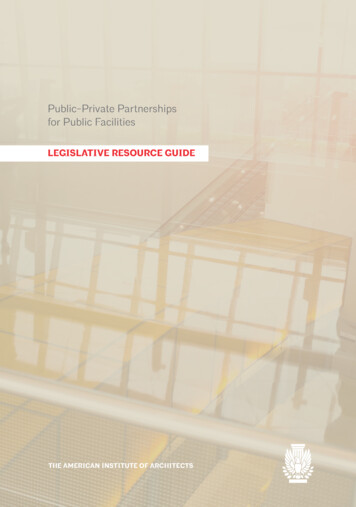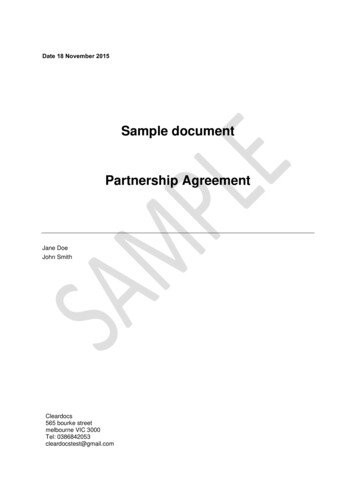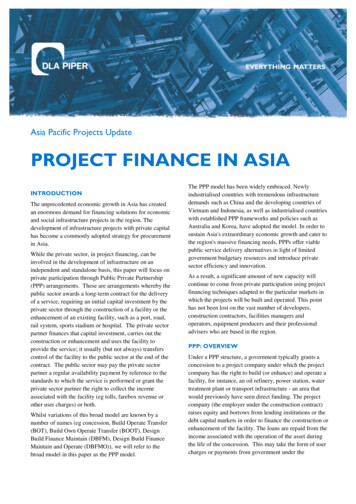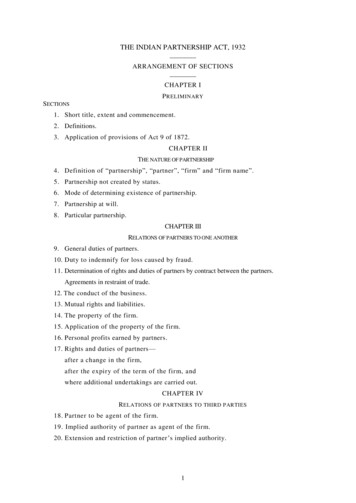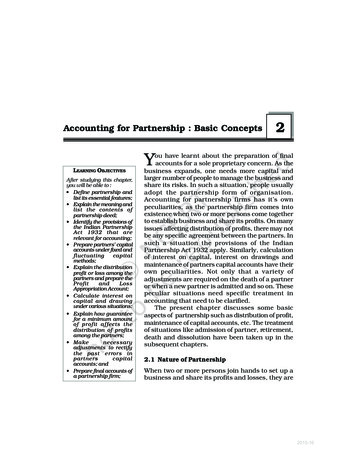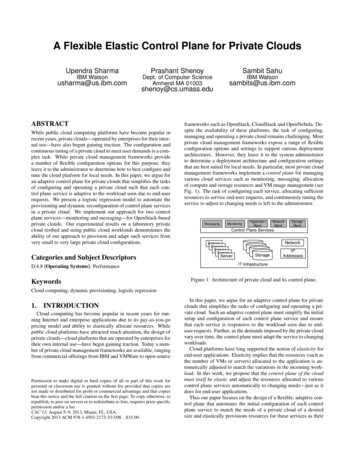
Transcription
A GUIDEBOOK ONPUBLIC-PRIVATE PARTNERSHIP ININFRASTRUCTUREECONOMIC AND SOCIAL COMMISSION FOR ASIA AND THE PACIFIC
This Guidebook was developed by Mr. Abdul Quium of the TransportDivision of ESCAP. Its development benefited from the work of thesecretariat in the area of public-private partnership in infrastructuredevelopment and interaction with practitioners from many countries.The Guidebook is based on an earlier developed Primer on publicprivate partnerships in infrastructure development.The views presented in the Guidebook may not necessarily beconsidered to represent the official views of the Secretariat of theUnited Nations.The designation employed and the presentation of the material in thispublication do not imply the expression of any opinion whatsoever onthe part of the Secretariat of the United Nations concerning the legalstatus of any country, territory, city or area or of its authorities, orconcerning the delimitation of the frontiers or boundaries. Mention offirm names and commercial products does not imply the endorsementof the United Nations.The Guidebook has been issued without formal editing.Copyright United Nations 2011UNESCAPBangkok, January 2011
iiA Guidebook on Public-Private Partnership in InfrastructureThe Purpose of this GuidebookPublic-private partnership (PPP) in infrastructure is a relatively newexperience in most developing countries of the Asian and Pacific region. Althoughmany governments have considered various steps to promote PPPs in theircountries, lack of capacity in the public sector remains to be one of the majorproblems in implementing PPP projects. So far, only few countries have establishedinstitutional arrangements and developed manuals and resource materials in supportof PPP development and for the capacity-building of their public officials. In theabsence of such established institutional arrangements and resource materials,public officials face difficulties in project development and implementation, andgeneral public can have many misunderstandings about PPPs.This Guidebook describes the overall process and activities usually involvedin PPP project development, implementation and management. It has beendeveloped as a general resource material for better understanding of the wholeprocess. The Guidebook also revisits some of the basics of PPPs to help understandthe process and the requirements for developing successful projects. As the actualprocess followed in a country depends on its administrative and institutionalarrangements, this Guidebook is not a substitute for manuals/advisory guidelinesthat many countries have developed and other countries may consider to develop.The Guidebook is divided into six chapters. Chapter 1 revisits the basics ofPPPs in infrastructure. It focuses on three things: the characteristics that make PPPsdifferent from conventional construction projects, models of PPPs, and the basicstructure of a PPP project.Chapter 2 considers the PPP process and the matters that need to be takeninto account before any project development starts.The preparatory activities prior to actual project development tasks areconsidered in Chapter 3. This chapter identifies the key tasks at the preparatorystage and makes elaborations on those tasks.Chapter 4 deals with project development and due diligence. It identifies thekey tasks involved in project development and describes the details of those tasks.Procurement is the subject of discussion in Chapter 5. This chapter describesthe typical activities involved in this stage.Chapter 6 is the last chapter of the Guidebook. It considers contractmanagement and dispute resolution. Manuals/handbooks and guidelines have been developed in many countries including Australia, Singaporeand South Africa. The development of this Guidebook has also benefited from these manuals andhandbooks as well as practices followed in those and other countries.
A Guidebook on Public-Private Partnership in iationsviPublic-Private Partnerships in Infrastructure: Revisiting the Basics1A. The characteristics that make PPPs different1B. Models of PPP4C. Understanding the basic structure of a PPP arrangement10Before Project Development: Understanding the Overall Process andthe Basic Requirements13A. The legal and regulatory environment and government policy13B. Main objectives that the project has to achieve15C. The PPP process in the country16D. Understanding the private sector’s requirements and capacity in thegovernment to implement the project18E. Good governance19Project Development I: Undertaking the Preparatory Activities20A. Project identification and preliminary internal stakeholder consultation20B. Scoping of the project21C. Identifying the major issues in project planning23D. Institutional due diligence23E. Establishment of a project management structure24F. Appointment of a transaction advisor25G. Establishment of a mechanism for stakeholder consultation, markettesting and information disclosure28Project Development II: The Feasibility Study and Due Diligence29A. Project planning and feasibility29B. Risk analysis and management34C. Financing40D. Value for money46E. Pricing policy and compensation to project company46F. Government support48G. Responsibilities of and liabilities on government51H. Regulatory arrangements52I. Service and output specifications52J. Terms of contract54
ivA Guidebook on Public-Private Partnership in Infrastructure5.6.K. Government approval55L. Dealing with unsolicited PPP project proposals56Project Implementation: Procurement and Construction58A. Legal and governance aspects in procurement58B. Implementation arrangement59C. Pre-procurement tasks60D. Procurement66E. Project construction70Post Project Implementation: Contract Management and DisputeResolution72A. Contract management72B. Dispute resolution74
A Guidebook on Public-Private Partnership in InfrastructureAbbreviationsADSCR Annual Debt Service Coverage ate-TransferBTOBuild-Transfer-OperateCAPMCapital Assets Pricing ModelCODCommercial Operation d-OperateDCMDesign-Construction- MaintenanceECAExport Credit AgencyEOIExpressions of InterestEPCEngineering, Procurement and ConstructionICDInland Container DepotIRRInternal Rate of ReturnLOALetter of AcceptanceLOILetter of IntentMCAModel Concession AgreementMIGAMultilateral Investment Guarantee Agency (an affiliate of the World Bank)MOUMemorandum of UnderstandingNPVNet Present ValueO&MOperation and MaintenancePFIPrivate Finance InitiativePLCRProject Life Coverage RatioPPIPrivate Participation in InfrastructurePPPPublic-Private PartnershipPSCPublic Sector ComparatorPSPPrivate Sector ParticipationPSOPublic Service ObligationRFPRequest for ProposalROEReturn on EquitySPVSpecial Purpose/Project VehicleTORTerms of ReferenceVATValue Added Taxv
viA Guidebook on Public-Private Partnership in InfrastructureUnited Nations Economic and Social Commissionfor Asia and the PacificTCTID Division, United Nations Building,Rajadamnern Lok AvenueBangkok 10200, ThailandTel: (66 2) 2881371 Fax: (66 2) 2806042Email: escap-ttd@un.orgAsian Institute of TransportDevelopment13 Palam Marg, Vasant ViharNew Delhi-110057 IndiaTel: (91 11) 26155309Fax: (91 11) 26156298Email:asianinstitute.del@gmail.com
A Guidebook on Public-Private Partnership in Infrastructure1CHAPTER 1PUBLIC-PRIVATE PARTNERSHIPS IN INFRASTRUCTURE:REVISITING THE BASICSThis chapter revisits the basics of public-private partnerships (PPP) ininfrastructure with a focus on: The characteristics that make PPPs different from conventional publicsector projects;Models in public-private partnerships; andThe basic structure of a PPP model.The public officials, involved in PPP project planning and development,implementation and contract management, need to have clear understanding ofthese basics.A. THE CHARACTERISTICS THAT MAKE PPPs DIFFERENT1.What is public-private partnership in infrastructure projects?Governments in most developing countries face the challenge to meet thegrowing demand for new and better infrastructure services. As available funding fromthe traditional sources and capacity in the public sector to implement many projectsat one time remain limited, governments have found that partnership with the privatesector is an attractive alternative to increase and improve the supply of infrastructureservices.The partners in a PPP, usually through a legally binding contract or someother mechanism, agree to share responsibilities related to implementation and/oroperation and management of an infrastructure project. This collaboration orpartnership is built on the expertise of each partner that meets clearly defined publicneeds through the appropriate allocation of 1 : ResourcesRisksResponsibilities, andRewardsIt is important to emphasize here that a PPP is not a solution option to aninfrastructure service problem but it is a viable project implementation mechanism fora preferred solution option.1.Adapted from the definition of PPP provided by the Canadian Council for PPPs (see the Council’s PPPdefinition at http://www.pppcouncil.ca/aboutPPP definition.asp). Some other terms such as private sectorparticipation (PSP) and private participation in infrastructure (PPI) are also used. These terms may notalways have the same meaning, however.
22.A Guidebook on Public-Private Partnership in InfrastructureWhat advantages PPPs may provide?Governments worldwide have increasingly turned to the private sector toprovide infrastructure services in energy and power, communication, transport andwater sectors that were once delivered by the public sector. There are severalreasons for the growing collaboration with the private sector in developing andproviding infrastructure services, which include: Increased efficiency in project delivery, and operation and management;Availability of additional resources to meet the growing needs ofinvestment in the sector; andAccess to advanced technology (both hardware and software).Properly executed planning and development of a project also allows betterscreening of options, and helps in deciding appropriate project structure and choiceof technology considering cost over the whole life cycle of the project.3. Should lack of government budget be the main factor in considering aPPP?Often, lack of government funding has been the main reason for considering aPPP option for a project. However, lack of government funding may not be the mainreason for deciding a PPP option for the implementation of a project. There areadditional costs for PPP projects – usually the cost of borrowing money is higher forthe private sector than for the public sector and there are administrative costs for themanagement of PPP contractual regimes. Transaction costs 2 of PPP projects canalso be substantial. PPP projects may also impose many explicit and implicitliabilities on the government.A project may not be considered for being implemented as a PPP projectunless efficiency gains from improved project delivery, operation and management,and access to advanced technology can offset the above-mentioned additionalcosts. In fact, many countries have established value for money as the main criterionin judging the merits of a PPP option for a project.4.Why PPPs are attractive to governments?PPPs have become attractive to governments as an off-budget mechanismfor infrastructure development as: They can enhance the supply of much-needed infrastructure services. They may not require any immediate cash spending.2.The development of a PPP project requires firms and governments to prepare and evaluate proposals,develop contract and bidding documents, conduct bidding and negotiate deals, and arrange funding. Thecosts incurred in these processes are called transaction costs, which include staff costs, placement fees andother financing costs, and advisory fees for investment bankers, lawyers, and consultants. Transaction costsmay range from 1 to 2 percent to well over 10 per cent of the project cost. Experts suggest that transactioncosts vary mainly with familiarity and stability of the policy and administrative environment and not so muchwith the size or technical characteristics of a project (See in Michael Klein et al. 1996. “Transaction costs inprivate infrastructure projects – are they too high?”, Public Policy for the Private Sector, Note Number 95,WorldBank,WashingtonD.C.Availableat: rnal/095klein.pdf .)
A Guidebook on Public-Private Partnership in Infrastructure 3They provide relief from the burden of the costs of design andconstruction.They allow transfer of many project risks to the private sector.They promise better project design, choice of technology, construction,operation and service delivery.5.How a PPP project is different from a conventional project?There are significant differences between a conventional constructionprocurement project and a PPP project that need to be clearly understood. The maindifferences include: PPP projects are different from conventional construction projects in termsof project development, implementation, and management. Theadministrative and approval processes in the case of PPP projects arealso different. A PPP project is viable essentially when a robust business model can bedeveloped. The focus of a PPP project should not be on delivering a particularclass/type of assets but on delivering specified services at defined quantityand levels. The risk allocation between the partners is at the heart of any PPPcontract design and is more complex than that of a conventionalconstruction project. Both partners should clearly understand the variousrisks involved and agree to an allocation of risks between them. A PPP contract generally has a much longer tenure than a constructioncontract. Managing the relationship between the private company and theimplementing agency over the contract tenure is vital for the success of aPPP project.6.Are there any limitations of PPPs?There are many important economic, social, political, legal, and administrativeaspects, which need to be carefully assessed before approvals of PPPs areconsidered by the government. PPPs have various limitations which should also betaken into account while they are being considered. The major limitations include: Not all projects are feasible (for various reasons: political, legal,commercial viability, etc.). The private sector may not take interest in a project due to perceived highrisks or may lack technical, financial or managerial capacity to implementthe project. A PPP project may be more costly unless additional costs (due to highertransaction and financing costs) can be off-set through efficiency gains. Change in operation and management control of an infrastructure assetthrough a PPP may not be sufficient to improve its economic performanceunless other necessary conditions are met. These conditions may includeappropriate sector and market reform, and change in operational andmanagement practices of infrastructure operation.
4A Guidebook on Public-Private Partnership in Infrastructure Often, the success of PPPs depends on regulatory efficiency.IMPORTANT CHARACTERISTICS OF PPP PROJECTS Promise of better project structure and design. Allows better screening of projects. A bad project is a bad projectno matter whether it is implemented by the public or the privatesector. Better choice of technology based on life-cycle costing. Better service delivery, especially if performance based payment isconsidered. Better chances of completion on time and within the budget. Risk of default.Project risks can easily turn into government risks.Various liabilities on government (direct and indirect).A long-term contract management system needs to be in place.An administrative mechanism and special skills in thegovernment are required to develop and implement PPPprojects.There can be underlying fiscal costs and contingent liabilities of PPPs on thegovernment that may arise in the medium- and -long-term. These underlying fiscalcosts and contingent liabilities on the government should be given due considerationwhen a PPP project is considered.B. MODELS OF PPPA wide spectrum of PPP models has emerged. These models vary mainly by: Ownership of capital assets; Responsibility for investment; Assumption of risks; and Duration of contract. The PPP models can be classified into five broad categories in order ofgenerally (but not always) increased involvement and assumption of risksby the private sector. The five broad categories are: Supply and management contracts Turnkey contracts Affermage/Lease Concessions Private Finance Initiative (PFI) and Private ownership.The basic features of these five categories of PPP models are shown infigure 1.
A Guidebook on Public-Private Partnership in Infrastructure5Figure 1. Basic features of PPP modelsPrivatesectorPrivateOwnershipPPP OptionsInvestmentConcessionLeasesTurnkeySupply &ManagementPublicsectorPublicsectorRisks, obligations and durationsPrivatesectorEach of these five categories has many variants. A categorization of thePPP/PSP models together with their main characteristics is shown in table 1 3 . Whilethe spectrum of models shown in the table are possible as individual options,combinations are also possible such as, a lease or (partial) privatization contract forexisting facilities which incorporates provisions for expansion through Build-OperateTransfer. In fact, many PPP projects of recent times are of combination type.Table 1. Classification of PPP modelsBroad categoryMain variantsOwnership ofcapital assetsOutsourcing PublicMaintenance PublicSupply andmanagementmanagementOperational icAffermage/Lease TPublic/PublicPrivate ownership BOO/DBFO Privateof assets and PFI nsibilityof investmentAssumption ic/Private Private/Public -30Indefinite10-20IndefiniteBuild-Lease-Transfer (BLT) is a variant.The use of various categorization terms in the table, and arrangements that go by these terms do not alwayshave the same features as set out in the table or mentioned in the discussion afterwards.
6A Guidebook on Public-Private Partnership in Infrastructure**Build-Operate-Transfer (BOT) has many other variants such as Build-Transfer-Operate (BTO), Build-OwnOperate-Transfer (BOOT) and Build-Rehabilitate-Operate-Transfer (BROT).***The Private Finance Initiative (PFI) model has many other names. In some cases, asset ownership may betransferred to, or retained by the public sector.The main features of each of the broad categories of the PPP models arediscussed next.Supply and management contractsA management contract is a contractual arrangement for the management ofa part or whole of a public enterprise (for example, a specialized port terminal forcontainer handling at a port or a utility) by the private sector. Management contractsallow private sector skills to be brought into service design and delivery, operationalcontrol, labour management and equipment procurement. However, the public sectorretains the ownership of facility and equipment. The private sector is assignedspecified responsibilities concerning a service and is generally not asked to assumecommercial risk.The private contractor is paid a fee to manage and operate services.Normally, the payment of such fees is performance-based. Usually, the contractperiod is short, typically three to five years 4 . But the period may be longer for largeand complex operational facilities such as a port or an airport.The main pros and cons of this model include the following:Pros: Can be implemented in a short time. Least complex of all PPP models. In some countries, politically and socially more acceptable for certainprojects (such as water projects and strategic projects like ports andairports).Cons: Efficiency gains may be limited and little incentive for the private sector toinvest. Almost all risks are borne by the public sector. Applicable mainly to existing infrastructure assets.TurnkeyTurnkey is a traditional public sector procurement model for infrastructurefacilities. Generally, a private contractor is selected through a bidding process. Theprivate contractor designs and builds a facility for a fixed fee, rate or total cost, whichis one of the key criteria in selecting the winning bid. The contractor assumes risksinvolved in the design and construction phases. The scale of investment by the4.For example, the initial management contract for Port Klang in Malaysia with a foreign company was only forthree years. The main purpose was to set-up the system so that eventually a local company could take overfor a longer period.
A Guidebook on Public-Private Partnership in Infrastructure7private sector is generally low and for a short-term. Typically, in this type ofarrangement, there is no strong incentive for early completion of the project. Thistype of private sector participation is also known as Design-Build.The main pros and cons of this model include the following:Pros: Well understood traditional model. Contract agreement is not complex. Generally, contract enforcement is not a major issue.Cons: The private sector has no strong incentive for early completion. All risks except those in the construction and installation phases are borneby the public sector. Low private investment for a limited period. Only limited innovation may be possible.Affermage/LeaseIn this category of arrangement, the operator (the leaseholder) is responsiblefor operating and maintaining the infrastructure facility (that already exists) andservices, but generally the operator is not required to make any large investment.However, often this model is applied in combination with other models such as buildrehabilitate-operate-transfer. In such a case, the contract period is generally muchlonger and the private sector is required to make significant investment.The arrangements in an affermage and a lease are very similar. Thedifference between them is technical. Under a lease, the operator retains revenuecollected from customers/users of the facility and makes a specified lease feepayment to the contracting authority. Under an affermage, the operator and thecontracting authority share revenue from customers/users.In the affermage/lease types of arrangements, the operator takes lease ofboth infrastructure and equipment from the government for an agreed period of time.Generally, the government undertakes the responsibility for investment and thusbears investment risks. The operational risks are transferred to the operator.However, as part of the lease, some assets also may be transferred on a permanentbasis for a period which extends over the economic life of assets. Fixed facilities andland are leased out for a longer period than for mobile assets. Land to be developedby the leaseholder is usually transferred for a period of 15-30 years.The main pros and cons of this model include the following:Pros: Can be implemented in a short time. Significant private investment possible under longer term agreements. In some countries, legally and politically more acceptable for strategicprojects like ports and airports.
8A Guidebook on Public-Private Partnership in InfrastructureCons: Has little incentive for the private sector to invest, particularly if the leaseperiod is short. Almost all risks are borne by the public sector. Generally used for existing infrastructure assets. Considerable regulatory oversight may be required.ConcessionsIn this form of PPP, the government defines and grants specific rights to anentity (usually a private company) to build and operate a facility for a fixed period oftime. The government may retain the ultimate ownership of the facility and/or right tosupply the services. In concessions, payments can take place both ways:concessionaire pays to government for the concession rights and the governmentmay pay the concessionaire, which it provides under the agreement to meet certainspecific conditions. Usually, such payments by the government may be necessary tomake projects commercially viable and/or reduce the level of commercial risk takenby the private sector, particularly in a developing or untested PPP market. Typicalconcession periods range between 5 to 50 years.The main pros and cons of this model include the following:Pros: Private sector bears a significant share of the risks. High level of private investment. Potential for efficiency gains in all phases of project development andimplementation and technological innovation is high.Cons: Highly complex to implement and administer. Difficult to implement in an untested PPP market. May have underlying fiscal costs to the government. Negotiation between parties and finally making a project deal may requirelong time. May require close regulatory oversight. Contingent liabilities on government in the medium and long term.In a Build-Operate-Transfer or BOT type of concession (and its other variantsnamely, Build-Transfer-Operate (BTO), Build-Rehabilitate-Operate-Transfer (BROT),Build-Lease-Transfer (BLT) type of arrangement), the concessionaire makesinvestments and operates the facility for a fixed period of time after which theownership reverts back to the public sector. In a BOT modal, operational andinvestment risks can be substantially transferred to the concessionaire.In a BOT model, the government has, however, explicit and implicit contingentliabilities that may arise due to loan guarantees and sub-ordinate loans provided,and default of a sub-sovereign government and public or private entity on nonguaranteed loans.
A Guidebook on Public-Private Partnership in Infrastructure9By retaining ultimate ownership, the government controls the policy and canallocate risks to parties that are best suited to assume or remove them. BOT projectsmay also require direct government support to make them commercially viable.The concessionaire’s revenue in a BOT project comes from managing andmarketing of the user facilities (for example, toll revenue in a toll road project) andrenting of commercial space where possible. Concessions for BOT projects can bestructured on either maximum revenue share for a fixed concession period orminimum concession period for a fixed revenue share, a combination of both, or onlyminimum concession period.Private Finance Initiative (PFI)In the private finance initiative model, the private sector remains responsiblefor the design, construction and operation of an infrastructure facility. In some cases,the public sector may relinquish the right of ownership of assets to the private sector.In this model, the public sector purchases infrastructure services from theprivate sector through a long-term agreement. PFI projects, therefore, bear directfinancial obligations to the government in any event. In addition, explicit and implicitcontingent liabilities may also arise due to loan guarantees provided to the lendersand default of a public or private entity on non-guaranteed loans.A PFI project can be structured on minimum payment by the government overa fixed contract tenure, or minimum contract tenure for a fixed annual payment, or acombination of both payment and tenure.In the PFI model, asset ownership at the end of the contract period isgenerally transferred to the public sector. Setting up of a Special Purpose Vehicle(SPV) may not be always necessary (see discussion on SPV in the followingsection). A PFI contract may be awarded to an existing company. For the purpose offinancing, the lenders may, however, require the establishment of an SPV. The PFImodel also has many variants.In a PFI project, as the same entity builds and operates the services, and ispaid for the successful supply of services at a pre-defined standard, the SPV /private company has no incentive to reduce the quality or quantity of services. Thisform of contractual agreement reduces the risks of cost overruns during the designand construction phases or of choosing an inefficient technology, since theoperator’s future earnings depend on controlling the costs. The public sector’s mainadvantages lie in the relief from bearing the costs of design and construction, thetransfer of certain risks to the private sector and the promise of better project design,construction and operation.The main pros and cons of this model are summarized below:Pros: Private sector may bear a significant share of the risks.
10A Guidebook on Public-Private Partnership in Infrastructure High level of private investment.Potential for efficiency gains and innovation is high.Attractive to private investors in an untested or developing PPP market.Most suitable for social sector infrastructure projects (schools, dormitories,hospitals, community facilities, etc.).Cons: Complex to implement and manage the contractual regimes. Government has direct financial liability. Negotiation between parties may require long time. Regulatory efficiency is very important. Contingent liabilities on the government in the medium and long term.Which model to select?The answer to this question needs careful assessment of many things.Each model has its own pros and cons and can be suitable for achieving themajor objectives of private-private partnership to a varying degree. Specialcharacteristics of some sectors and their technological development, legal andregulatory regimes, and public an
BROT Build-Rehabilitate-Operate-Transfer BTO Build-Transfer-Operate CAPM Capital Assets Pricing Model COD Commercial Operation Date DBFO Design-Build-Finance-Operate DBO Design-Build-Operate DCM Design-Construction- Maintenance ECA Export Credit Agency EOI Expressions of Interest EPC Engineering, Procurement and Construction .


